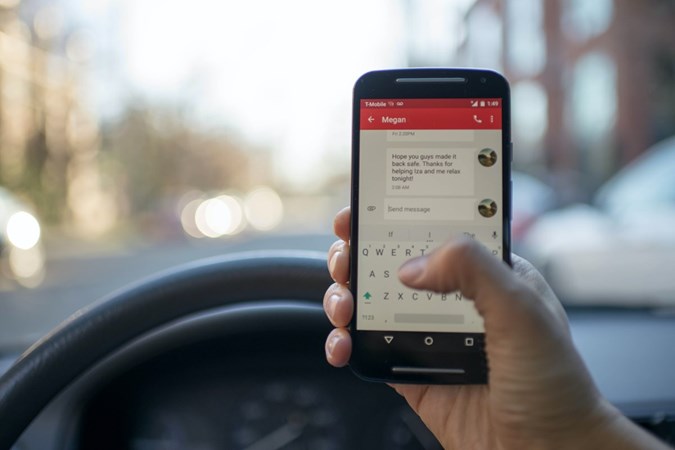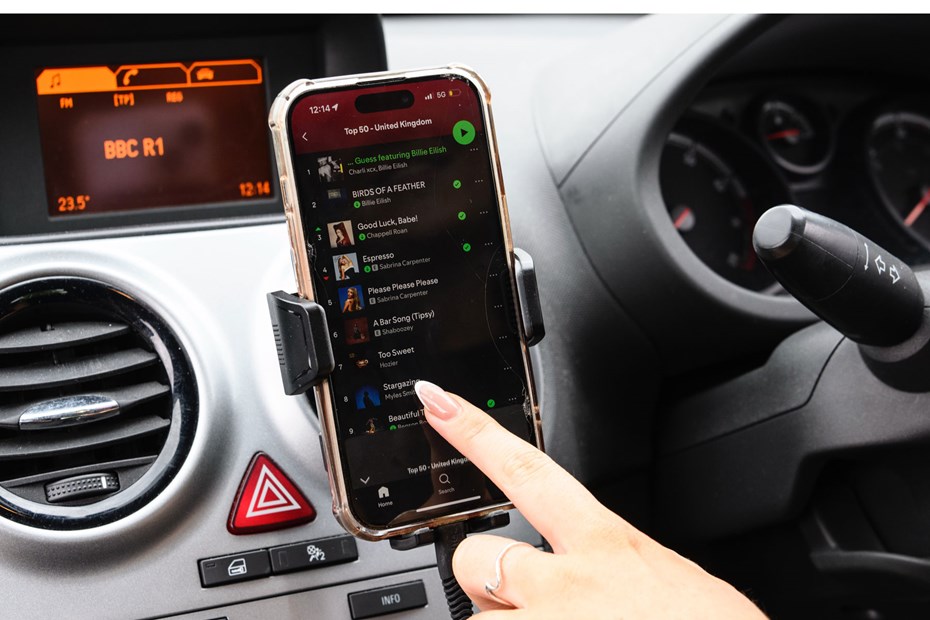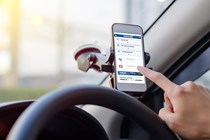Most of us like to stay entertained while driving, whether by making a quick call or changing music on our smartphones. Using a phone while driving has been illegal in the UK for years, but changes in 2022 closed some loopholes. The changes were clearly needed — Home Office data reveals that hand-held phone use behind the wheel has surged by over 90% in the past two years. Prosecutions reached a seven-year high, with 13,332 drivers convicted in 2023, compared to 6,990 in 2022. And this figure only reflects those who were caught by the police.
It’s worth mentioning that the majority of new cars come equipped with features like Apple CarPlay and Android Auto, or at the very least, Bluetooth connectivity. These systems enable hands-free phone use and make it completely unnecessary to physically pick up your phone whilst driving.
In this guide we’ll help you understand why the new phone laws were introduced, when you can use your phone in the car and what to do if your car doesn’t have the tech to keep you legal.
What new rules on using a mobile phone while driving were introduced in 2022?
The big change introduced in 2022 was a tightening of the rules to make it illegal to touch your phone at all while driving, or even when stopped in traffic.
Previously, the law had only banned hand-held calls and messaging – so-called ‘interactive communication’. Using your phone for anything else such as scrolling through playlists, taking photos and videos, or setting navigation was, in effect, entirely legal. Though prosecutions were brought for using a phone in these ways, they were successfully challenged and the charges dropped.
The rule changes introduced in 2022 closed those loopholes. Any hand-held use of a mobile phone while driving is now punishable with a fine and points on your driving license. You may face even harsher punishment if caught making a video call while driving. These rules also apply if you’re supervising a learner driver. Get caught twice and you face an instant ban from driving.
In a genuine emergency, when it’s necessary to call 999 and there’s no safe place to stop, some flexibility will be shown if you have to get your phone out. If your car has an SOS call button, you should use that instead.

Can I use my phone in a cradle while driving?
If your phone is attached to your car’s windscreen, dashboard or air vent, using a phone cradle, you’re not contravening any rules. Indeed, you’re doing the sensible thing, especially if you need to use your phone for navigation.
However, you are not allowed to touch your phone for any reason. If you really need to handle your phone, stop in a safe place and turn the car’s engine off. In an ideal world, your phone will be connected to the car’s Bluetooth, or you’ll use its voice controls. That way you can make and receive calls without even taking your hands off the steering wheel. If your car doesn’t have Bluetooth, you can get a receiver that plugs into your car’s stereo.
Note that making video calls, even with your phone in a cradle, is an absolute no-no that can attract severe punishment.
The rules don’t prohibit touching your car’s infotainment system display while driving, however if the system has voice control you should use it in preference to the touchscreen or clickwheel. The offence of driving without due care and attention still exists and if the police stop you because they believe you were dangerously distracted by something in the car, whatever it is, you could face prosecution.
Is it legal to use a phone as sat nav?
Yes, it is. However, you can’t touch your phone for any reason while driving. If you need to touch your phone to accept a route change or set a new destination, stop in a safe place and turn the car’s engine off to do so. Or use your phone’s voice controls.
To use sat nav, you should have your phone in a cradle somewhere close to your line of sight. If it’s down by the gear lever, it could be considered a distraction. If it’s on the windscreen, within the area that’s cleared by the wipers, it’s considered an obstruction.
Am I likely to get caught if I keep my mobile out of view?
It’s an old trick, this, holding your phone down by your side so no-one can see that it’s in your hand. But that won’t cut it anymore, especially on the motorway. Ten police forces across the country are currently rolling out new AI technology, designed to detect drivers not wearing a seatbelt or using a mobile phone while driving.
The new type of technology captures footage of passing motorists, which is then processed using artificial intelligence to determine whether the driver is using a handheld phone. The police are subsequently provided with the images to assess if any action needs to be taken.
What’s more, many cars have a driver attention monitor that sounds a warning or gives some other form of prompt to focus you back on the road if you have become distracted. Such systems are able to detect mobile phone usage and are now compulsory in new cars.
Can you use your phone while parked with the engine running?
In a word, no. Even if you’ve pulled up in a roadside lay-by, or stopped in a car park, you’re still considered to be driving when you’re sat in the driver’s seat and the engine is running. You should at least turn the engine off and, if it’s safe to do so, get out of the car before handling your phone.
You’re also not allowed to touch your phone when sat in stationary traffic, regardless of whether or not the engine is running. There is, however, one very specific exception to the rules.

What’s the exception to the law about using your mobile when driving?
You may well be one of the fast-growing number of people who use their phone to pay for things. You may even have stopped carrying your bank and credit cards entirely. If this is your preferred payment method, you can handle your phone if you need to pay for something while sat in your car’s driver’s seat. For instance, if you’re using a drive through or paying a road toll.
FAQs
What are the penalties if I get caught holding a phone while driving?
You’ll be issued with a wallet-denting £200 fine and given six penalty points on your driving license. Get caught again and you’ll be up to the maximum 12 points and therefore be automatically disqualified from driving for six months, possibly more if other motoring offences are on your record.
Depending on how long you’re banned for, you may have to retake both a theory and practical driving test to get your license back. All at your own cost.
Can I use my Apple watch whilst driving?
No you can’t. Similar rules governing phone use apply to Apple and smartwatches. While they offer convenient features like checking time, making payments, and answering calls, using them while driving can lead to fines up to £1000 and points on your license if caught.
Are these rules really necessary?
Distracted driving has been proven to be more dangerous than drink- or drug-driving and there’s a national campaign to make it as stigmatised as drink-driving. There are some circumstances in which becoming distracted is unavoidable, for instance if you have crying children in the car. However, by handling a phone you’re essentially choosing to become distracted, hence the clampdown on that behaviour.
Road safety manager of England for the Royal Society for the Prevention of Accidents, Rebecca Needham, said: “The change in the law and updates to the Highway Code further underscore the importance of clear and enforceable penalties for distracted drivers and this will help change the belief that holding a phone is consequence-free. Using a mobile phone behind the wheel has been shown to reflect a deep-seated and irresponsible attitude rather than an in-the-moment reaction.”









